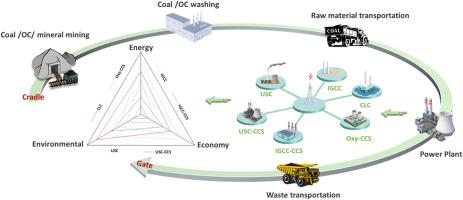Journal of Environmental Chemical Engineering ( IF 7.7 ) Pub Date : 2021-07-27 , DOI: 10.1016/j.jece.2021.106121 Ying-jie Zhao 1, 2 , Yuan-yuan Duan 1, 2 , Qian Liu 1 , Yang Cui 1, 2 , Usama Mohamed 3 , Yu-ke Zhang 1, 2 , Zhi-li Ren 1 , Yi-feng Shao 1 , Qun Yi 2, 4 , Li-juan Shi 2, 4 , William Nimmo 3

|
Coal-based chemical looping combustion (CLC) power plant presents itself as a promising technology due to its low energy penalty which is associated with its inherent CO2 capture process. However, most evaluations and comparisons (energy efficiency, economic, and environmental aspects) of the CLC power plant generally were focused on the power plant operation stage. Life cycle assessment (LCA) method with a “cradle to gate” model involving power plant construction, operation, and decommissioning stage,of coal-based power plants was established. Following that the resource consumption, energy consumption, environmental impact potential, and economic performance in the life cycle, were comprehensively compared between the coal-based CLC power plant and other plants such as IGCC, USC and oxy-combustion power plants with and without (w/o) CO2 capture, to find out the potential and deficiency of the coal-based CLC power plant in a life cycle perspective. Results showed that energy resource consumption accounts for the largest proportion of the total resource consumption (81.88-91.89%) in six coal-fired power plants. Among the environmental impact potentials, smoke and dust potential (SAP) has the highest value while eutrophication potential (EP) resulted in the lowest in six coal-based power plants. CLC presented resource depletion indicator, energy payback ratio and the total life cycle costs, at 4.79×10-6 kWh/person/day, 3.22, and 0.138 $/kWh, respectively. These power plants were ranked from highest to lowest according to their sustainability as the following USC, CLC, IGCC, oxy-CCS, USC-CCS, and IGCC-CCS. However, CLC presents the best sustainability in all coal-based power plants with CO2 capture. The CLC power plant will be one of the most attractive options for carbon reduction in coal-based power systems, as the development of CLC technology further improves energy efficiency and economic performance. The results further demonstrated that the coal-based CLC power plant can solve the issues involving CO2 emission reduction and energy utilization in coal to power generation process from lifecycle viewpoint.
中文翻译:

煤基 CLC 发电厂与 IGCC、USC 和有/没有 CO2 捕集的氧燃烧发电厂的生命周期能源-经济-环境评价
煤基化学循环燃烧 (CLC) 发电厂因其固有的 CO 2能量损失低而成为一项有前途的技术捕获过程。然而,CLC 电厂的大多数评估和比较(能源效率、经济和环境方面)通常都集中在电厂运行阶段。建立了煤电厂建设、运行和退役阶段的“从摇篮到门”模型生命周期评估(LCA)方法。随后,综合比较了煤基CLC电厂与IGCC、USC、富氧电厂等电厂在全生命周期内的资源消耗、能源消耗、环境影响潜力和经济绩效( w/o) CO 2捕捉,从生命周期的角度找出煤基CLC发电厂的潜力和不足。结果表明,在六家燃煤电厂中,能源资源消耗占资源消耗总量的比重最大(81.88-91.89%)。在环境影响潜势中,烟尘潜势(SAP)的值最高,而富营养化潜势(EP)在六个燃煤电厂中最低。CLC 以 4.79×10 -6呈现资源消耗指标、能源回收率和总生命周期成本千瓦时/人/天,分别为 3.22 美元和 0.138 美元/千瓦时。这些发电厂根据其可持续性从高到低排列为以下 USC、CLC、IGCC、oxy-CCS、USC-CCS 和 IGCC-CCS。然而,CLC 在所有采用 CO 2捕获的煤电厂中表现出最佳的可持续性。随着 CLC 技术的发展进一步提高能源效率和经济绩效,CLC 发电厂将成为煤基电力系统减碳最有吸引力的选择之一。结果进一步表明,煤基CLC电厂可以从生命周期的角度解决煤发电过程中涉及CO 2减排和能源利用的问题。


























 京公网安备 11010802027423号
京公网安备 11010802027423号